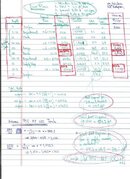All,
I computed the attached plan last night for practice and to show to a freshly minted diver. Then I thought it might be helpful to others.
Here's the skinny: Gas management plan for a 100 fsw air dive to the 25 min NDL limit. Diver is assumed to have a swimming RMV of 0.5 cuft/min, and will dive with "sufficient" reserves in case of emergency, descend at 60 fpm, stop briefly during descent at 10 fsw for a buddy/safety check, ascend at 30 fpm, and stop during ascent at 15 fsw for a 3 min safety stop. These calculations show that an Al 80 is insufficient, perhaps, for this dive, so assumes a PST HP 100 will be used. Dive will be turned either at 13:50 min:sec runtime or at 2,632 psig (whichever occurs first). Ascent will commence at 25:00 or 1,860 psig. Diver will surface at 31:20 with 1,640 psig remaining. Note: These calculations suggest that if the diver chooses instead to dive an Al 80 and carry his reserve gas in a pony, then the minimum size of this pony should be 30 cu ft.
Dive Safely (and apologies for my handwriting),
Ronald
I computed the attached plan last night for practice and to show to a freshly minted diver. Then I thought it might be helpful to others.
Here's the skinny: Gas management plan for a 100 fsw air dive to the 25 min NDL limit. Diver is assumed to have a swimming RMV of 0.5 cuft/min, and will dive with "sufficient" reserves in case of emergency, descend at 60 fpm, stop briefly during descent at 10 fsw for a buddy/safety check, ascend at 30 fpm, and stop during ascent at 15 fsw for a 3 min safety stop. These calculations show that an Al 80 is insufficient, perhaps, for this dive, so assumes a PST HP 100 will be used. Dive will be turned either at 13:50 min:sec runtime or at 2,632 psig (whichever occurs first). Ascent will commence at 25:00 or 1,860 psig. Diver will surface at 31:20 with 1,640 psig remaining. Note: These calculations suggest that if the diver chooses instead to dive an Al 80 and carry his reserve gas in a pony, then the minimum size of this pony should be 30 cu ft.
Dive Safely (and apologies for my handwriting),
Ronald





